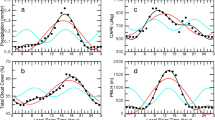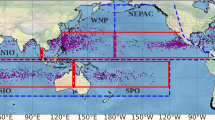Abstract
ECMWF reanalysis (ERA–interim) data of winds for two solar cycles (1991–2012) are harmonically analyzed to delineate the characteristics and variability of diurnal tide over a tropical site (13.5° N, 79.5° E). The diurnal cycle horizontal winds measured by Gadanki (13.5° N, 79.2° E) mesosphere–stratosphere–troposphere (MST) radar between May 2005 and April 2006 have been used to compute 24 h tidal amplitudes and phases and compared with the corresponding results obtained from ERA winds. The climatological diurnal tidal amplitudes and phases have been estimated from surface to ∼33 km using ERA interim data. The amplitudes and phases obtained in the present study are found to compare reasonably well with Global Scale Wave Model (GSWM–09). Diurnal tides show larger amplitudes in the lower troposphere below 5 km during summer and in the mid-stratosphere mainly during equinoctial months and early winter. Water vapor and convection in the lower troposphere are observed to play major roles in exciting 24-h tide. Correlations between diurnal amplitude and integrated water vapor and between diurnal amplitude and outgoing longwave radiation (OLR) are 0.59 and −0.34, respectively. Ozone mixing ratio correlates (ρ = 0.66) well with diurnal amplitude and shows annual variation in the troposphere whereas semi-annual variation is observed at stratospheric heights with stronger peaks in equinoctial months. A clear annual variation of diurnal amplitude is displayed in the troposphere and interannual variability becomes prominent in the stratosphere which could be partly due to the influence of equatorial stratospheric QBO. The influence of solar activity on diurnal oscillations is found to be insignificant.










Similar content being viewed by others
References
Alexander SP, Tsuda T (2008) Observations of the diurnal tide during seven intensive radiosonde campaigns in Australia and Indonesia. J Geophys Res 113:D04109. doi:10.1029/2007JD008717
Ambaum MHP, Hoskins BJ (2002) The NAO troposphere–stratosphere connection. J Clim 15:1969–1978
Burrage MD, Hagan ME, Skinner WR, Wu DL, Hays PB (1995) Long-term variability in the solar diurnal tide observed by HRDI and simulated by the GSWM. Geophys Res Letts 22(19):2641–2644. doi:10.1029/95GL02635
Chang LC, Palo SE, Liu HL (2011) Short–term variability in the migrating diurnal tide caused by interactions with the quasi 2 day wave. J Geophys Res 116:D12112. doi:10.1029/2010JD014996
Chapman S, Lindzen RS (1970) Atmospheric tides. Springer, New York
Chen W, Takahashi M, Graf H–F (2003) Interannual variations of stationary planetary wave activity in the northern winter troposphere and stratosphere and their relations to NAM and SST. J Geophys Res 108(D24):4797. doi:10.1029/2003JD003834
Dhaka SK, Malik V, Shibagaki Y, Hashiguchi H, Fukao S, Shimomai T, Chun H–Y, Takahashi M (2014) Comparison of vertical wavelengths of gravity waves emitted by convection in the UTLS region at Koto Tabang (0.20°S, 100.32°E) and Gadanki (13.5°N, 79.2°E) using radars. Indian J Radio Space Phys 43(1):24–40
Dutta G, Ajay Kumar MC, Vinay Kumar P, Ratnam MV, Chandrashekar M, Shibagaki Y, Mohammad S, and Basha HA (2009) Characteristics of high–frequency gravity waves generated by tropical deep convection: case studies. J Geophys Res 114(D18109), doi: 10.1029/2008JD011332.
Dutta G, Bapiraju B, Balasubrahmanyam P, Siddiqui MAA, Basha HA (2002) Seasonal variation of solar tides in the troposphere and lower stratosphere over Gadanki: comparisons with the global scale wave model. Radio Sci 37(2), doi: 10.1029/2000RS002571.
Ekanayake EMP, Aso T, Miyahara S (1997) Background wind effect on propagation of nonmigrating diurnal tides in the middle atmosphere. J Atmos Solar Terr Phys 59:401–429
Forbes JM (1995) Tidal and planetary waves, in the upper mesosphere and lower thermosphere: a review of experiment and theory. Geophys Monogr Ser 87:67–87
Fritts DC, Isler JR (1994) Mean motions and tidal and two-day structure and variability in the mesosphere and lower thermosphere over Hawaii. J Atmos Sci 51:2145–2164
Fritts DC, Vincent RA (1987) Mesospheric momentum flux studies at Adelaide, Australia: observations and a gravity wave–tidal interaction model. J Atmos Sci 44:605–619
Gurubaran S, Rajaram R, Nakamura T, Tsuda T (2005) Interannual variability of diurnal tide in the tropical mesopause region: a signature of the El Nino–Southern Oscillation (ENSO). Geophys Res Lett 32:L13805. doi:10.1029/2005GL022928
Hagan ME, Forbes JM, Vial F (1995) On modeling migrating solar tides. Geophys Res Lett 22:893–896
Hagan ME, Forbes JM (2002) Migrating and nonmigrating diurnal tides in the middle and upper atmosphere excited by tropospheric latent het release. J Geophys Res 107(D24):4754. doi:10.1029/2001JD001236
Hagan ME, Maute A, Roble RG, Richmond AD, Immel TJ, England SL (2007) Connections between deep tropical clouds and the Earth’s ionosphere. Geophys Res Lett 34:L20109. doi:10.1029/2007GL030142
Hall GE, Namboothiri SP, Manson AH, Meek CE (1995) Daily tidal, planetary wave and gravity wave amplitudes over the Canadian Prairies. J Atmos Terr Phys 57:1553–1567
Hocking WK, Hocking A (2002) Temperature tides determined with meteor radar. Ann Geophys 20:1447–1467
Kishore Kumar G, Singer W, Oberheide J, Grieger N, Batista PP, Riggin DM, Clemesha BR (2014a) Diurnal tides at low latitudes: radar, satellite, and model results. J Atmos Solar Terr Phys 118:96–105, doi: 10.1016/j.jastp.2013.07.005.
Kishore Kumar G, Kumar KK, Singer W, Zülicke C, Gurubaran S, Baumgarten G, Ramkumar G, Sathishkumar S, Rapp M (2014b) Mesospere and lower thermosphere zonal wind variations over low latitudes: relations to local stratospheric zonal winds and global circulation anomalies. J. Geophy. Res. Atmos. 119, 5913 – 5927, doi:10.1002/2014JD021610.
Kodera K, Kuroda Y (2002) Dynamical response to the solar cycle. J Geophys Res 107(D24):4749. doi:10.1029/2002JD002224
Kumar KK (2006) VHF radar observations of convectively generated gravity waves: some new insights. Geophys Res Lett 33:L01815. doi:10.1029/2005GL024109
McCormack JP, Hood LL (1996) Apparent solar cycle variations of upper stratospheric ozone and temperature: latitude and seasonal dependencies. J Geophys Res 101:20933–20944
McCormack JP, Eckermann SD, Hoppel KW, Vincent RA (2010) Amplification of the quasi–two day wave through nonlinear interaction with the migrating diurnal tide. Geophys Res Lett 37:L16810. doi:10.1029/2010GL043906
Meek CE, Manson AH, Drummond JR (2011) Test of diurnal and semidiurnal tidal analysis of temperatures from SABER–like sampling of a realistic global model, CMAM–DAS. Ann Geophys 29:723–730. doi:10.5194/angeo-29-723-2011
Narendra Babu A, Kumar KK, Kishore Kumar G, Ratnam MV, Rao SVB, Rao DN (2008) Long–term MST radar observations of vertical wave number spectra of gravity waves in the tropical troposphere over Gadanki (13.5° N, 79.2° E): comparison with model spectra. Ann Geophys 26:1671–1680. doi:10.5194/angeo-26-1671-2008
Ogi M, Yamazaki K, Tachibana Y (2003) Solar cycle modulation of the seasonal linkage of the North Atlantic Oscillation (NAO). Geophys Res Lett 30(22):2170. doi:10.1029/2003GL018545
Ratnam MV, Rao NV, Vedavathi C, Krishnamurthy BV, Rao SVB (2014) Diurnal tide in the low-latitude troposphere and stratosphere: long-term trends and role of the extended solar minimum. J Atmos Sol Terr Phys 121:168–176
Riggin DM, Kudeki E, Feng Z, Sarango MF, Lieberman RS (2002) Jicamarca radar observations of the diurnal and semidiurnal tide in the troposphere and lower stratosphere. J Geophys Res 107(D8):4062. doi:10.1029/2001JD001216
Sakazaki T, Fujiwara M, Zhang X, Hagan ME, Forbes JM (2012) Diurnal tides from the troposphere to the lower mesosphere as deduced from TIMED/SABER satellite data and six global reanalysis data sets. J Geophys Res 117:D13108. doi:10.1029/2011JD017117
Sakazaki T, Sato K, Kawatani Y, Watanabe S (2015) Three-dimensional structures of tropical nonmigrating tides in a high-vertical-resolution general circulation model. J Geophys Res Atmos 120:1759–1775. doi:10.1002/2014JD022464
Sasi MN, Krishnamurthy BV (1990) Diurnal and semidiurnal tides in the middle atmosphere over Balasore (21.5°N, 86.9°E). J Atmos Sci 47:2101–2107
Sasi MN, Ramkumar G, Deepa V (1998) Nonmigrating diurnal tides in the troposphere and lower stratosphere over Gadanki (13.5°N, 79.2°E). J Geophys Res 103:19485–19494
Seidel DJ, Free M, Wang J (2005) Diurnal cycle of upper-air temperature estimated from radiosondes. J Geophys Res 110:D09102. doi:10.1029/2004JD005526
Tsuda T, Nakamura T, Shimizu A, Yoshino T, Harijono SWB, Sribimawati T, Wiryosumarto H (1997) Observations of diurnal oscillations with a meteor wind radar and radiosondes in Indonesia. J Geophys Res 102(D22):26217–26224
Tsuda T, Ratnam MV, May PT, Alexander MJ, Vincent RA, MacKinnon A (2004) Characteristics of gravity waves with short vertical wavelengths observed with radiosonde and GPS occultation during DAWEX (Darwin Area Wave Experiment). J Geophys Res 109:D20S03. doi:10.1029/2004JD004946
Vincent RA, Kovalam S, Fritts DC, Isler JR (1998) Long term MF radar observations of solar tides in the low-latitude mesosphere: interannual variability and comparisons with the GSWM. J Geophys Res 103(D8):8667–8683
Wallace JM, Patton DB (1970) Diurnal temperature variations: surface to 25 kilometers. Mon Weather Rev 98:548–552
Williams CR, Avery SK (1996) Diurnal nonmigrating tidal oscillations forced by deep convective clouds. J Geophys Res 101(D2):4079–4091
Wu DL, Jiang JH (2005) Interannual and seasonal variations of diurnal tide, gravity wave, ozone, water vapor as observed by MLS during 1991–1994. Adv Space Res 35:1999–2004
Zhang X, Forbes JM, Hagan ME (2010a) Longitudinal variation of tides in MLT region: 1. Tides driven by tropospheric net radiative heating. J Geophys Res 115: A06316, doi:10.1029/2009JA014897.
Zhang X, Forbes JM, Hagan ME (2010b) Longitudinal variation of tides in MLT region: 2. Relative effects of solar radiative and latent heating. J Geophys Res 115: A06317 doi:10.1029/2009JA014898.
Zhang X, Forbes JM, Hagan ME (2011) Seasonal-latitudinal variation of the eastward-propagating diurnal tide with zonal wavenumber 3 in the MLT: influences of heating and background wind distribution. J Atmos Terr Phys 78–79:37–43. doi:10.1016/j.jastp.2011.03.005
Acknowledgments
ERA–interim data were provided by the European Centre for Medium-Range Weather Forecasts (ECMWF) through their web site. Two of the authors, P. Vinay Kumar and Salauddin Mohammad, are thankful for the research fellowship offered by Indian Space Research Organization (ISRO) under its Climate And Weather of Sun–Earth System (CAWSES–II) program. We acknowledge Dr. B. Bapiraju and Dr. P.V. Rao for their kind suggestions. Authors are grateful to anonymous reviewers for their constructive comments. The authors also thank the college management for their kind encouragement.
Author information
Authors and Affiliations
Corresponding author
Rights and permissions
About this article
Cite this article
Kumar, P.V., Dutta, G., Mohammad, S. et al. Climatology of diurnal tide and its long-term variability in the lower middle atmosphere over a tropical station. Theor Appl Climatol 130, 151–162 (2017). https://doi.org/10.1007/s00704-016-1871-1
Received:
Accepted:
Published:
Issue Date:
DOI: https://doi.org/10.1007/s00704-016-1871-1




